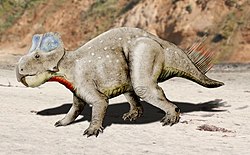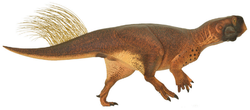| Zhuchengceratops Temporal range: Campanian ~ | |
|---|---|
 | |
| Life restoration | |
| Scientific classification | |
| Kingdom: | Animalia |
| Phylum: | Chordata |
| Class: | Reptilia |
| Clade: | Dinosauria |
| Clade: | † Ornithischia |
| Clade: | † Ceratopsia |
| Family: | † Leptoceratopsidae |
| Genus: | † Zhuchengceratops Xu et al., 2010 |
| Species: | †Z. inexpectus |
| Binomial name | |
| †Zhuchengceratops inexpectus Xu et al., 2010 | |
Zhuchengceratops is a genus of extinct leptoceratopsid ceratopsian that lived during the Upper Cretaceous of modern-day China. It was first described in 2010, by Xu et al., who created the binomial Zhuchengceratops inexpectus. The name is derived from the location of Zhucheng, the Latinized-Greek ceratops, or "horned face", and the unexpected articulated nature of the holotype. The skeleton was found in the Wangshi Group, which is of Late Cretaceous age, and most fossils are only disarticulated bones of Shantungosaurus .
Contents
Zhuchengceratops shares many features with Leptoceratopsidae as well as other ceratopsian groups such as Ceratopsidae. The overall size of the taxon was similar to Leptoceratops , although slightly larger. Zhuchengceratops was analyzed to be in a group with Leptoceratops and Udanoceratops , although internal relationships of this triplet were unresolved.




